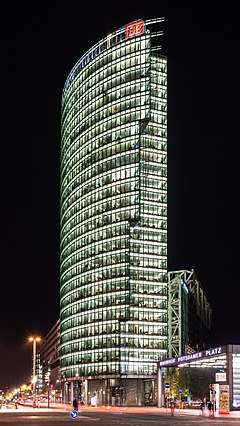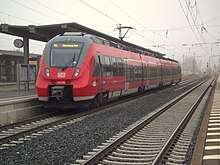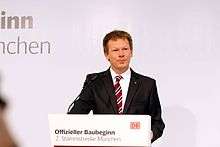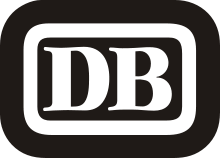Deutsche Bahn
Deutsche Bahn AG (IPA: [ˈdɔʏtʃə baːn]; abbreviated as DB or DB AG) is a German railway company. Headquartered in Berlin, it is a private joint-stock company (AG), with the Federal Republic of Germany being its single shareholder.[2][3]
 | |
| Aktiengesellschaft | |
| Industry | Railway transport, Logistics |
| Predecessor |
|
| Founded | 1 January 1994 |
| Headquarters | , |
Area served | Europe |
Key people | Richard Lutz, CEO |
| Products | Rail transport, cargo transport, services |
| Revenue | |
| Owner | Federal Republic of Germany (100%) |
Number of employees | 295,653 (2013) |
| Website | www |

Deutsche Bahn describes itself as the second-largest transport company in the world, after the German postal and logistics company Deutsche Post / DHL, and is the largest railway operator and infrastructure owner in Europe. Deutsche Bahn was the largest railway company in the world by revenue in 2015.[4] It carries about two billion passengers annually.
The group is divided into several companies, including DB Fernverkehr (long-distance passenger), DB Regio (local passenger services) and DB Cargo (rail freight). The Group subsidiary DB Netz also operates large parts of the German railway infrastructure and thus the largest rail network in Europe.
In rail transport, the company generates about half of its total revenue. The other half of the operating business comprises the further transport and logistics business as well as various service providers. The company generates part of its sales through public transport contracts; support will also be provided for maintenance and expansion of the infrastructure.
Passenger transport companies carried around 4.4 billion passengers in 2016 with their trains and buses. In 2016 DB logistics companies transported 277 million tons of goods in rail freight transport.[5]
Company profile
The Deutsche Bahn Group is divided into various organizational units that perform their tasks with subsidiaries.
Personenverkehr
DB Personenverkehr is the group that manages passenger travel within Germany. Originally called Reise & Touristik (English: Travel and Tourism), this group is responsible for the managing, servicing and running of German passenger services. This group is divided into three business areas: DB Fernverkehr, DB Regio and Arriva.
Arriva
.jpg)
Deutsche Bahn placed a bid in May 2010 for the UK-based transport company Arriva. Arriva runs bus and rail companies in 12 European countries. The merger was approved by the European Commission in August 2010, subject to DB divesting Arriva services in Germany (these are now run as Netinera). The merger became effective on 27 August 2010.[6]
Services in the UK formerly run as DB Regio are now operated by a new subdivision of the company, Arriva UK Trains. It operates the Chiltern Railways, and CrossCountry franchises as well as open-access operator Grand Central. It also operates the London Overground concession as Arriva Rail London. The former Tyne & Wear Metro operations, already started by DB Regio UK, ended in 2017, while Arriva Trains Wales services passed to Transport for Wales in 2018.
DB Fernverkehr
DB Fernverkehr AG is a semi-independent division of Deutsche Bahn that operates long-distance passenger trains in Germany. It was founded in 1999 in the second stage of the privatisation of German Federal Railways under the name of DB Reise & Touristik and renamed in 2003.
DB Fernverkehr operates all InterCityExpress and InterCity trains in Germany as well as in some neighboring countries and several EuroCity and EuroCityExpress trains throughout Europe. Unlike its sister companies DB Regio and DB Cargo, DB Fernverkehr still holds a de facto monopoly in its segment of the market as it operates hundreds of trains per day, while all competitors' long-distance services combined amount to no more than 10–15 trains per day.
Additionally DB Fernverkehr operates a few long-distance coach services throughout Germany, called IC Bus.
DB Regio

DB Regio AG is the subsidiary of Deutsche Bahn that operates passenger trains on short and medium distances in Germany. Unlike its long-distance counterpart, DB Fernverkehr, it does not operate trains on its own account. Traffic is ordered and paid for by the Bundesländer (states) or their respective SPNV-Aufgabenträger (Regional train operation supervisors).
Some states have awarded long-term contracts to DB Regio (usually 10 to 15 years), in others, DB Regio's operations are decreasing, in North Rhine-Westphalia, their market share is expected to be lower than 50%. DB Regio rail services are divided into several regional companies:
- DB Regio Nord for Schleswig-Holstein, Hamburg, Lower Saxony, Bremen
- DB Regio Nordost for Berlin, Brandenburg, Mecklenburg-Vorpommern
- DB Regio NRW for North Rhine-Westphalia
- DB Regio Südost for Saxony, Saxony-Anhalt, Thuringia
- DB Regio Hessen for Hesse
- DB Regio Südwest for Rhineland-Palatinate, Saarland, parts of Baden-Württemberg and Hesse
- DB Regio Baden-Württemberg for the rest of Baden-Württemberg
- DB Regio Bayern for Bavaria
- S-Bahn Hamburg
- S-Bahn Berlin
- RegioNetz (small, independent networks, like Erzgebirgsbahn, Gäubodenbahn, Kurhessenbahn, Oberweißbacher Bergbahn, Südostbayernbahn, Westfrankenbahn for easier organisation)
The bus services consist of 25 bus companies, which have subsidiary companies themselves.
Infrastructure
DB Netze
The infrastructure division is divided into the DB Netz (rail infrastructure), DB Station&Service (stations and services) and DB Energie (Energy) business units.
DB Engineering&Consulting
DB Engineering & Consulting, which is responsible for construction supervision, construction planning and maintenance, is also assigned to this department without being part of a business area.
Via its subsidiary DB Engineering&Consulting, DB signed a memorandum of understanding with Iranian rail operator Bonyad Eastern Railways (BonRail) in May 2017 and shortly after a consulting contract with Islamic Republic of Iran Railways; both projects were abandoned after the United States imposed new sanctions against Iran and said firms doing business with Iran would be barred from doing business with the United States.[7]
The California High-Speed Rail Authority's (CHSRA) board approved on November 15, 2017 an early train operator contract with DB Engineering & Consulting USA.[8] The firm is the U.S. arm of Deutsche Bahn AG. As early train operator, DB Engineering & Consulting will assist CHSRA with planning, designing and implementing the state's high-speed rail program.
In Germany, DB E&C acts as a planning office and in construction supervision for Deutsche Bahn construction sites.
Logistics
The Transport and Logistics division acted in the market with the business units DB Schenker Logistics and DB Schenker Rail, which were combined under the umbrella of DB Schenker, and the Intermodal division, which operates in combined transport. In 2016, rail freight transport was separated from logistics and DB Schenker Rail was renamed DB Cargo.
Foreign firms
DB also has interests abroad, owning the United Kingdom's largest rail freight operator, DB Cargo UK, which also operates the British Royal Train[9] and also has interests in Eastern Europe. It is possible to obtain train times for any journey in Europe from Deutsche Bahn's website.[10]
Trans-Eurasia Logistics is a joint venture with Russian Railways (RŽD) that operates container freight trains between Germany and China via Russia.
Key persons

Board of directors
- Richard Lutz, CEO since 2017
- Levin Holle, CFO and Chief Executive for logistics
- Sigrid Nikutta, Chief Executive of DB Cargo and rail freight
- Berthold Huber, Chief Executive for passenger services
- Sabina Jeschke, CTO
- Martin Seiler, CHRO
- Ronald Pofalla, Chief Executive for infrastructure
History
While the railway network in Germany dates back to 1835 when the first tracks were laid on a 6 km (3.7 mi) route between Nuremberg and Fürth, Deutsche Bahn has been a relatively recent development in German railway history. On January 1, 1994, Deutsche Reichsbahn and Deutsche Bundesbahn were merged to form one company, and so, they became Deutsche Bahn. At the same time, Deutsche Bahn adopted its current logo and DB abbreviation. Kurt Weidemann modernised the logo and typographer Erik Spiekermann designed a new corporate font known as DB Type. When Deutsche Bahn was formed in January 1994, it became a joint stock-company, and were designed to operate the railways of both the former East and West Germany after unification in October 1990 as a single, uniform, and private company.[11] There are three main periods of development in this unified German railway: its formation, its early years (1994–1999), and the period from 1999 to the present.
Originally, DBAG had its headquarters in Frankfurt am Main but moved to Potsdamer Platz in central Berlin in 1996, where it occupies a 26-storey office tower designed by Helmut Jahn at the eastern end of the Sony Center and named Bahntower. As the lease was to expire in 2010, DB had announced plans to relocate to Berlin Hauptbahnhof, and in 2007 a proposal for a new headquarters by 3XN Architects won an architectural competition which also included Foster + Partners, Dominique Perrault and Auer + Weber.[12] However, these plans were put on hold due to the financial crisis of 2008, and the Bahntower lease was extended.[13] Construction of the new headquarters building was started in 2017 under the title "Cube Berlin" according to the designs by 3XN. Finished in February 2020, the Cube will house the legal offices of Deutsche Bahn, but not become the main headquarters.[14]
1999 to present
The second step of the Bahnreform (Railway reform) was carried out in 1999. All rolling stock, track, personnel, and real assets were divided between the holdial subsidiaries of DBAG: DB Reise & Touristik AG (long-distance passenger service, later renamed DB Station & Service AG (operating the stations). This new organisational scheme was introduced not least to implement European Community directive 91/440/EEC that demands access to railway systems free of discrimination.
In December 2007, DB reorganised again, bringing all passenger services into its DB Bahn arm, logistics under DB Schenker and infrastructure and operations under DB Netze.
The DB is owned by the Federal Republic. By the Constitution, the Federal Republic is required to retain (directly or indirectly) a majority of the infrastructure (the present DB Netze) stocks.
In 2008, it was agreed to "float" a portion of the business, meaning an end to the 100% share the German Federal Republic had in it, with a plan that 25% of the overall share would be sold to the private sector.[15] However the onset of the financial crisis of 2007–08 saw this cancelled.[16]
In 2014, the Jewish community of Thessaloniki demanded that the Deutsche Bahn, which is the successor of the Deutsche Reichsbahn, should reimburse the heirs of Greek Holocaust victims of Thessaloniki for train fares that they were forced to pay for their deportation from Thessaloniki to Auschwitz and Treblinka between March and August 1943.[17][18]
In June 2018 controversy grew in the United Kingdom over widespread cancellations of railway services and numerous delayed services operated by Deutsche Bahn in Britain, under its Northern brand. This resulted in Britain's Minister of Transport, Chris Grayling, setting up an enquiry into whether the Deutsche Bahn subsidiary had breached its contractual agreement to provide railway services in the north of England. He warned that if the company was found to be in breach of its contractual agreements it could be banned from running railway services in the United Kingdom.[19]
Logo history
 Deutsche Bahn's second and former logo as Deutsche Reichsbahn used from April 1, 1920 to April 26, 1945.
Deutsche Bahn's second and former logo as Deutsche Reichsbahn used from April 1, 1920 to April 26, 1945. Deutsche Bahn's third and previous logo as Deutsche Reichsbahn used from August 30, 1924 to December 31, 1993.
Deutsche Bahn's third and previous logo as Deutsche Reichsbahn used from August 30, 1924 to December 31, 1993.
This logo were used in tandem with the 1920 logo until April 27, 1945. Deutsche Bahn's previous secondary logo as Deutsche Bundesbahn used from October 10, 1946 to December 31, 1993.
Deutsche Bahn's previous secondary logo as Deutsche Bundesbahn used from October 10, 1946 to December 31, 1993. Deutsche Bahn's fourth and current logo since January 1, 1994.
Deutsche Bahn's fourth and current logo since January 1, 1994.
Structure and subsidiaries
Train categories
Trains in Germany are classified by their stopping pattern:[20]
- Fernverkehr (long-distance trains), also Fernzug
- ECE (EuroCity Express) for international high-speed rail services. Currently only one route from Frankfurt to Milan while other international high-speed services are called ICE International
- ICE (Intercity-Express) for high-speed long-distance train services between major cities and regions. Does also cross European borders.
- EC (EuroCity) for IC trains that cross borders, and connects Germany with other countries. Can also be operated by foreign State Railways. Can have carriages from various European countries.
- IC (InterCity) for long-distance semi-high-speed services, that connects regions and cities. Serves as a "mini ICE" with trains reaching high speed (average around 160 – 220 km/h) , but stops more frequently, and in smaller cities than ICE services. On some IC lines the trains go on older railways instead of the high speed lines the ICE takes. International IC services are usually operated As Euro-City.
- Nahverkehr (local trains)
- IRE (Interregio-Express) longer distance RE trains, that connects regions and cities. Serves as slower IC trains. IRE trains only exist in Baden-Württemberg and on the Hamburg–Berlin route
- RE (Regional-Express) serves regions and connects cities, and does not stop at every Station on the route.
- RB (Regionalbahn) stops at all stations on the route (except where S-Bahn is available) and is the most basic train service
- S (S-Bahn) is rapid transit and most services stop at all stations. S-Bahn operate high-frequency services and are comparable with, for example, the London Overground
Train categories no longer used include:
- MET (Metropolitan) was a luxury train service between Hamburg and Cologne. The two special MET train sets are now used for IC and ICE services, and does still have a comfort level above the regular IC and ICE coaches
- IR (InterRegio), set between RE and IC was meant to connect cities and regions at a lower price, but also be used for local traffic. Replaced partly by IC, RE and IRE
- SE (Stadt-Express) operated as a mixture of RE and RB: trains skipped many stations in urban areas but made all stops in the countryside. Rebranded as RE and RB. In some regions, such as Rhine-Main (Frankfurt, Rhein-Main-Verkehrsverbund), the local transit authority advertised trains as SE. Internally, DB classified them as either RE or RB, but even DB trains display "SE" on their destination boards. This ceased in December 2016.
In the early days of DBAG, the most basic train categories, which were in use since the early days of rail travel in Germany, were also used:
- D (D-Zug or Schnellzug, abbreviated from Durchgangszug) was the express train category and used to be the highest train category. It was replaced by IC and the even faster ICE. The trains of the SyltShuttle plus car shuttle service connecting the island of Sylt with the mainland are still officially referred to as D trains
- E (Eilzug) was the semi-fast service offering faster journeys than normal passenger trains but not at such long distances and speed as D trains, though there were some quite long running E trains. No direct successor, would be located between RE and IC
- N (Nahverkehrszug), the most basic form of train service stopping at all stations. When all local train services were vertaktet, i.e. operating at a fixed interval (mostly one train per hour), they were rebranded as RB
There are several other operators in Germany which sometimes offer other categories, also, a local transport authority or tariff associations might brand the trains in a different way than DB does. For example, in the Nuremberg region, RE and RB trains are not differentiated, but called R instead. In some regions, such as Verkehrsverbund Berlin-Brandenburg, private operators do use the RE and RB labels, in others, such as Saxony, they do not. In online and print information systems of DB, private trains officially labelled RB and RE by their operators, might get a different label, for example "ABR" for trains operated by Abellio, though on platforms, trains and maps or timetables issued by the local transport authority overseeing regional train services, these abbreviations usually do not appear.
Codeshare agreements
In conjunction with Emirates, China Airlines, TAM Airlines, Turkish Airlines, Biman Bangladesh Airlines, and Lufthansa, Deutsche Bahn operates the AIRail Service between Frankfurt Airport and Köln Hauptbahnhof/Bonn Hauptbahnhof, Düsseldorf, Freiburg, Hamburg, Hanover, Mannheim, Munich, Nuremberg, and Stuttgart. Deutsche Bahn has the IATA designator 2A.[21]
Tickets
DB offers two different pricing models:
- The Flexpreis (originally Normalpreis): gives full flexbility, i.e. all trains on the given date can be used on the chosen route
- The Sparpreis or Super-Sparpreis is the cheaper, advanced fare. Prices for long-distance journeys start as low as €19.90, but Sparpreis tickets are only valid on ICE, IC or EC trains noted on the ticket.
Local trains (S, RB, RE, IRE) also accept tickets issued by local transport associations, which can also be used on buses, trams, and U-Bahn trains.
DB offers concessionary fares with the BahnCard, which is available as BahnCard 25 (25% discount on Flexpreis and Sparpreis), BahnCard 50 (50% discount on Flexpreis and 25% discount on Sparpreis), and BahnCard 100 (unlimited travel on all Deutsche Bahn trains, a few private train companies and also in many local transport associations).
Other special tickets, such as Interrail or the Länder-Tickets, give unlimited journeys on local trains and in many transport associations within a state, are also available. These Länder-Tickets offer group tickets, where up to five people can travel on a single ticket.[22]
See also
References
- Deutsche Bahn AG. "Annual Report 2016". Archived from the original on 2017-12-27. Retrieved 2017-12-27.
- "Members to the Supervisory Board of Deutsche Bahn AG". Archived from the original on 2012-10-25.
- "Deutsche Bahn AG at a glance". Deutsche Bahn. Archived from the original on 26 April 2009.
- http://www.railway-technology.com/features/featureengines-of-trade-the-ten-biggest-rail-companies-by-revenue-4943955/featureengines-of-trade-the-ten-biggest-rail-companies-by-revenue-4943955-1.html
- Deutsche Bahn Facts & Figures 2016. Deutsche Bahn. 2016.
- "EC approves DB's takeover of Arriva". Railway Gazette International. London. 11 August 2010. Retrieved 2010-08-19.
- Gernot Heller and Douglas Busvine (August 16, 2018), German rail operator, Deutsche Telekom end Iran projects Reuters.
- http://www.progressiverailroading.com/high_speed_rail/news/California-high-speed-rail-agency-selects-German-firm-as-early-train-operator--53285
- Macalister, Terry (28 June 2007). "Deutsche Bahn to run Queen's train". The Guardian.
- Tickets - Timetable Archived 2006-04-07 at the Wayback Machine
- "The foundation of Deutsche Bahn AG" company website
- "Competition win for 3XN". World Architecture News. 21 December 2007. Retrieved 30 October 2009.
- http://www.ftd.de/unternehmen/handel_dienstleister/:Deutsche%20Bahn%20Pl%E4ne%20Umzug/346601.html%5B%5D
- Jürgens, Isabell (2020-02-19). "„Cube Berlin" – Europas schlauestes Gebäude geht in Betrieb". www.morgenpost.de (in German). Retrieved 2020-06-07.
- "Partial sale of DB agreed" Railway Gazette International May 2008 page 289
- "DB flotation on hold" Railway Gazette International November 2008 page 843
- One way tickets Thessaloniki – Auschwitz Archived 2017-02-08 at the Wayback Machine, June 2015
- Zug der Erinnerung/Thessaloniki Zug der Erinnerung (non-government organisation “Train of Commemoration”).
- Gwyn Topham, Helen Pidd and Pippa Crerar, 'Northern and GTR could be barred from rail franchises' in The Guardian (UK newspaper), 4 June 2018
- "Produktübersicht" on DB AG website
- Deutsche Bahn AG. "DB Mobility Logistics Facts and figures 2012" (PDF). Archived from the original (PDF) on 2013-06-16. Retrieved 2013-07-07.
- "Regional Tickets". Deutsche Bahn.
External links
![]()
